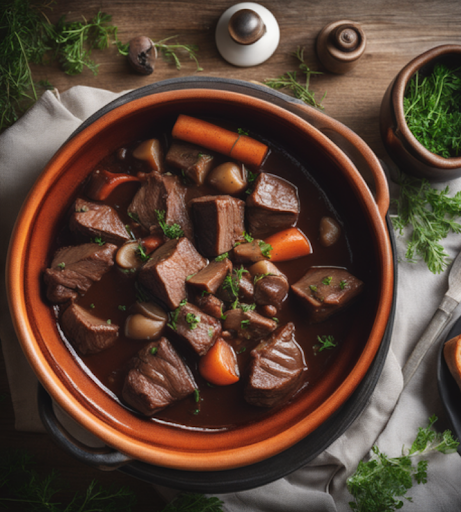Boeuf Bourguignon (Burgundy)
Boeuf Bourguignon is a testament to the culinary heritage of Burgundy, a region known for its exceptional wines and culinary traditions. It is said to have originated as a peasant dish, where tough cuts of beef were slow-cooked in red wine to tenderize them. The dish was made with ingredients readily available in the region, such as Burgundy wine, onions, carrots, and mushrooms. Over the years, it has gained popularity and is now celebrated not only in Burgundy but also in French cuisine as a whole.
Jump to Recipe Print Recipe
A Tapestry of Flavors: Influences on Burgundy Cuisine
Burgundy’s cuisine reflects a fascinating blend of historical, geographical, and cultural influences that have shaped its unique character. Here’s a closer look at the key contributors:
1. Geography and Climate:
- Continental Climate: Four distinct seasons influence the availability of ingredients. Hearty stews and braises dominate colder months, while lighter fare with fresh produce takes centre stage during warmer ones.
- Abundant Forests: The region’s forests provide a bounty of mushrooms, adding depth and character to dishes.
- Rich Pastures: Rolling hills provide ideal grazing land for prized Charolais cattle, a signature protein in Burgundian cuisine.
2. Monastic Tradition:
- Monasteries: Monks historically played a significant role in agriculture and food preservation. Techniques like pickling, salting, and cheesemaking were honed within monasteries, leaving a lasting impact on the region’s culinary practices.
- Fasting Periods: The emphasis on lean protein, such as fish and poultry, during religious fasting days is still evident in some lighter dishes.
3. Historical Trade Routes:
- Roman Influence: The Romans introduced grapevines to the region, laying the foundation for the world-renowned Burgundy wines that became an integral part of the cuisine.
- Spice Trade: Spices like saffron and cloves were brought along trade routes and added a touch of exoticism to some regional dishes.
4. Culinary Exchange with Neighboring Regions:
- Germany: Similarities can be found in slow-cooking techniques and the use of cabbage in dishes like Choucroute Garnie (a rich sauerkraut stew).
- Switzerland: Cheesemaking traditions share some influence, with regional specialities like Epoisses de Bourgogne reflecting a unique Burgundian twist.
5. Modernization and Innovation:
- Lighter Options: Today’s chefs are incorporating lighter cooking styles while retaining the essence of traditional recipes.
- Seasonal Focus: Emphasis is placed on using fresh, local ingredients, showcasing the changing seasons on the plate.
Understanding these influences allows you to appreciate the rich tapestry of flavours that make Burgundy cuisine unique. From the hearty stews to the delicate pastries, each bite tells a story of the region’s history, geography, and cultural heritage.

Boeuf Bourguignon (Burgundy)
Equipment
- 1 Dutch Oven Or a heavy bottomed caserole pot
Ingredients
- 800 g beef such as chuck or sirloin, cut into cubes
- 200 g bacon chopped
- 200 g carrots peeled and sliced
- 200 g onions diced
- 200 g mushrooms sliced
- 3 cloves garlic minced
- 750 ml red wine preferably Burgundy
- 500 ml beef broth
- 30 g all-purpose flour
- 30 g butter
- 2 tablespoons olive oil
- 2 bay leaves
- 2 sprigs of thyme
- Salt and pepper to taste
Instructions
- In a large Dutch oven or heavy-bottomed pot, heat the olive oil over medium-high heat. Add the bacon and cook until it becomes crisp. Remove the bacon and set it aside.
- Season the beef cubes with salt and pepper, then add them to the pot. Sear the beef on all sides until it’s browned. Remove the beef and set it aside.
- In the same pot, add the onions, carrots, and mushrooms. Cook them for about 5 minutes until they start to soften. Add the minced garlic and cook for an additional minute.
- Sprinkle the flour over the vegetables and stir well to coat them evenly. Cook for 2-3 minutes to remove the raw flour taste.
- Return the beef and bacon to the pot. Pour in the red wine and beef broth, ensuring the ingredients are well submerged. Add the bay leaves and thyme sprigs. Bring the mixture to a boil, then reduce the heat to low, cover, and simmer for 2.5 to 3 hours, or until the beef is tender.
- In the last 15 minutes of cooking, melt the butter in a separate pan and sauté the mushrooms until they’re browned and tender. Add the mushrooms to the stew.
- Season the Boeuf Bourguignon with additional salt and pepper if needed. Remove the bay leaves and thyme sprigs before serving.
- Serve the Boeuf Bourguignon hot, preferably over mashed potatoes or with a side of crusty bread to soak up the rich sauce.

Leave a Reply